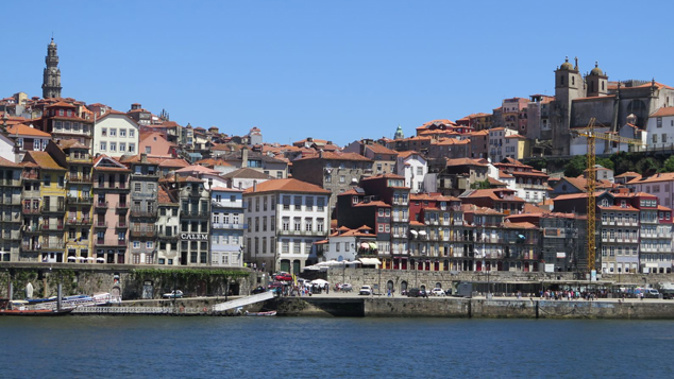
Huddled on the steep banks of the River Douro, and fondly referred to as the City of Bridges, Oporto is an unmistakeably intoxicating city, the sort of place that instantly sweeps you under its spell.
My first foray to this treasured city was experienced on Trafalgar’s Best of Portugal tour. It’s unquestionably a highlight - easy to love and hard to leave. With its Gothic spires, stately beaux-arts landmarks, exuberant Baroque churches, hand-painted ceramic tiles emblazoned across building facades, evocative back streets, riverside eateries and legendary trading stature in port wine, every pocket of Oporto reveals a different layer of intrigue. It’s the sort of place you’ll find frozen-in-time little shops selling nighties and sewing machines. The historic heart of the city, Riberia, is studded with remarkable architecture and backdropped with exceptional beauty, which helped elevate it on to UNESCO’s World Heritage list, twenty years ago.
Across the water on the left bank of the river is Gaia, the heavily prodigious district of wine lodges, where port is left to age in barrels before being shipped worldwide. Oporto ,Portugal’s second largest city, resembles a pop up city in many respects, because many of the historic buildings appear to be piled on top of one another. From a distance, gazing at this terraced pile of higgledy-piggledy terracotta rooftops, it looks like an impenetrable jigsaw puzzle.
Within the labyrinth of the winding cobbled lanes, Riberia exudes an unpretentious beauty, with rustic edges, faded splendour, and even ramshackle rows of buildings that are all the more endearing for their ragged honesty. They are now the subject of a concerted 40 year preservation project to strengthen them, without gentrifying their crumbling, raggedy visage. Despite its hilly flanks, it’s a surprisingly compact and relatively easy city to explore on foot.
Essential sights include the Lello, possibly the most beautiful bookshop in the world. Constructed in 1906, it exudes a sense of fantasy. Within the neo-Gothic exterior, I entered its grand magical interior of dark timber panelled walls with hand-carved wooden shelves, stained-glass windows and ceiling, and where a sweeping central staircase is festooned with vivid red steps.
There is a movie-set mystique about the Lello – no wonder J.K. Rowling was apparently inspired by it. The bookshop exemplifies the old city’s bygone charm, as does the spectacularly ornamented Café Majestic, where you are seated on leather banquettes beneath Art Deco chandeliers, attended to by waiters in crisp white jackets. Nearly a hundred years old, this Oporto institution was a much-loved haunt of J.K. Rowling, when she lived here. According to her biography, she spent many hours at the Majestic working on her first book, "Harry Potter and the Philosopher's Stone", while drinking cimbalinos on the second floor.
Unique to Oporto, a cimbalino is the local term for an espresso, deriving from the name of Portugal’s first espresso machines, which were branded, “La Cimbali.” My local Trafalgar guide ushered us inside the vast and unpromising exterior of Palácio da Bolsa, the city’s former stock exchange, commissioned by the city’s merchants. It’s rather drab appearance is breathtakingly misleading, because once inside, you’ll go weak at the knees when you clap your eyes on the unbelievably stately rooms, fit for royalty. Those old merchants certainly weren’t short of cash. The rooms are exquisitely and irresistibly ornate, every inch is decorated with exotic wood, intricate plasterwork, stained glass and acres of gold leaf. The show-stopper is the Arab Room.
Built between 1862 and 1880 and decorated in the extravagant Moorish Revival style, it is still used as reception hall for visiting personalities and heads of state. Right next door, St. Francis church is not dissimilar, its humble exterior belies a triumphant interior of Baroque excess. Dating back to 1383, its Gothic bones were embellished with Baroque extravagance 350 years later, when the interior walls, pillars, side chapels and roof, were covered with Portuguese gilt wood work. It’s a masterpiece worth admiring.
In this city of bridges, the most emblematic is the glorious Dom Luis I bridge. Named in honour of the king who commissioned it, it was designed by Teophile Seyrig, a former pupil of Gustave Eiffel. Taking five years to build, this dazzling double-decker wrought-iron blockbuster was the longest span bridge of its type, when it opened in 1886. For more than a century, the bridge carried road traffic across both decks. Nowadays, the top deck is used by light rail commuter trains and a pedestrian walkway has been developed, delivering lip-smacking views across Oporto, for willing sky-walkers.
Nine years earlier, and just before he constructed Paris’ fabled landmark, Eiffel constructed the Dona Maria Pia Bridge, further down the river, which at the time was the world’s longest single arch bridge and constructed to carry Lisbon-bound trains across the Douro. The Fench flock here in their droves to admire the ironwork creations, given their shared connection. You can marvel at these twin river spanning masterpieces by taking a Douro cruise. Do it at twilight, when the setting sun bathes Oporto’s architectural treasures in a golden glow.
For nocturnal adventure, take a stroll down the riverfront of Ribeira, which is flanked by an abundance of alfresco eateries and bars, bursting with character, housed in slender old houses, clad in yellow and blue mosaic tiles. Live street theatre and musicians fill the air with a carnival-like atmosphere, deep into the night. I’d be back here in a heartbeat.
By Mike Yardley, Newstalk ZB’s Travel Correspondent on Jack Tame Saturdays. 11.20am
Take your Radio, Podcasts and Music with you









